The Influence of Temperature Inversion on the Vertical Distribution of Aerosols
Abstract
1. Introduction
2. Data and Methodology
2.1. Raman Lidar Data
2.2. Methodology
2.2.1. Retrieval Method of TI
2.2.2. Retrieval Method of AOD
3. Results and Discussion
3.1. Statistical Properties of TI
3.2. Case Study
3.3. Effect of TI on the Vertical Distribution of Aerosols
4. Conclusions
Supplementary Materials
Author Contributions
Funding
Data Availability Statement
Conflicts of Interest
References
- Li, J.; Chen, H.; Li, Z.; Wang, P.; Fan, X.; He, W.; Zhang, J. Analysis of low-level temperature inversions and their effects on aerosols in the lower atmosphere. Adv. Atmos. Sci. 2019, 36, 1235–1250. [Google Scholar] [CrossRef]
- Kassomenos, P.A.; Koletsis, I.G. Seasonal variation of the temperature inversions over Athens, Greece. Int. J. Climatol. 2005, 25, 1651–1663. [Google Scholar] [CrossRef]
- Hu, X.-M.; Ma, Z.; Lin, W.; Zhang, H.; Hu, J.; Wang, Y.; Xu, X.; Fuentes, J.D.; Xue, M. Impact of the Loess Plateau on the atmospheric boundary layer structure and air quality in the North China Plain: A case study. Sci. Total Environ. 2014, 499, 228–237. [Google Scholar] [CrossRef] [PubMed]
- Kukkonen, J.; Pohjola, M.; Sokhi, R.S.; Luhana, L.; Kitwiroon, N.; Fragkou, L.; Rantamäki, M.; Berge, E.; Ødegaard, V.; Slørdal, L.H. Analysis and evaluation of selected local-scale PM10 air pollution episodes in four European cities: Helsinki, London, Milan and Oslo. Atmos. Environ. 2005, 39, 2759–2773. [Google Scholar] [CrossRef]
- Dong, X.; Xi, B.; Minnis, P. A climatology of midlatitude continental clouds from the ARM SGP central facility. Part II: Cloud fraction and surface radiative forcing. J. Clim. 2006, 19, 1765–1783. [Google Scholar] [CrossRef]
- Fedorovich, E.; Kaiser, R.; Rau, M.; Plate, E. Wind tunnel study of turbulent flow structure in the convective boundary layer capped by a temperature inversion. J. Atmos. Sci. 1996, 53, 1273–1289. [Google Scholar] [CrossRef]
- Wallace, J.; Corr, D.; Kanaroglou, P. Topographic and spatial impacts of temperature inversions on air quality using mobile air pollution surveys. Sci. Total Environ. 2010, 408, 5086–5096. [Google Scholar] [CrossRef]
- Wendisch, M.; Mertes, S.; Ruggaber, A.; Nakajima, T. Vertical profiles of aerosol and radiation and the influence of a temperature inversion: Measurements and radiative transfer calculations. J. Appl. Meteorol. Climatol. 1996, 35, 1703–1715. [Google Scholar] [CrossRef]
- Pei, Z.; Han, G.; Ma, X.; Shi, T.; Gong, W. A method for estimating the background column concentration of CO2 using the lagrangian approach. IEEE Trans. Geosci. Remote Sens. 2022, 60, 4108112. [Google Scholar] [CrossRef]
- Hirdman, D.; Burkhart, J.F.; Sodemann, H.; Eckhardt, S.; Jefferson, A.; Quinn, P.K.; Sharma, S.; Ström, J.; Stohl, A. Long-term trends of black carbon and sulphate aerosol in the Arctic: Changes in atmospheric transport and source region emissions. Atmos. Chem. Phys. 2010, 10, 9351–9368. [Google Scholar] [CrossRef]
- Li, H.; Shi, R.; Jin, S.; Wang, W.; Fan, R.; Zhang, Y.; Liu, B.; Zhao, P.; Gong, W.; Zhao, Y. Study of Persistent Haze Pollution in Winter over Jinan (China) Based on Ground-Based and Satellite Observations. Remote Sens. 2021, 13, 4862. [Google Scholar] [CrossRef]
- Thomas, M.A.; Devasthale, A.; Tjernström, M.; Ekman, A.M. The relation between aerosol vertical distribution and temperature inversions in the Arctic in winter and spring. Geophys. Res. Lett. 2019, 46, 2836–2845. [Google Scholar] [CrossRef]
- Bourgeois, Q.; Ekman, A.M.; Renard, J.-B.; Krejci, R.; Devasthale, A.; Bender, F.A.-M.; Riipinen, I.; Berthet, G.; Tackett, J.L. How much of the global aerosol optical depth is found in the boundary layer and free troposphere? Atmos. Chem. Phys. 2018, 18, 7709–7720. [Google Scholar] [CrossRef]
- Ramanathan, V.; Crutzen, P.J.; Kiehl, J.; Rosenfeld, D. Aerosols, climate, and the hydrological cycle. Science 2001, 294, 2119–2124. [Google Scholar] [CrossRef]
- Shi, T.; Han, G.; Ma, X.; Gong, W.; Chen, W.; Liu, J.; Zhang, X.; Pei, Z.; Gou, H.; Bu, L. Quantifying CO2 uptakes over oceans using LIDAR: A tentative experiment in Bohai bay. Geophys. Res. Lett. 2021, 48, e2020GL091160. [Google Scholar] [CrossRef]
- Xu, W.; Wang, W.; Wang, N.; Chen, B. A New Algorithm for Himawari-8 Aerosol Optical Depth Retrieval by Integrating Regional PM2.5 Concentrations. IEEE Trans. Geosci. Remote Sens. 2022, 60, 4106711. [Google Scholar] [CrossRef]
- Generoso, S.; Bey, I.; Labonne, M.; Bréon, F.M. Aerosol vertical distribution in dust outflow over the Atlantic: Comparisons between GEOS-Chem and Cloud-aerosol Lidar and Infrared Pathfinder Satellite Observation (CALIPSO). J. Geophys. Res. Atmos. 2008, 113, D24209. [Google Scholar] [CrossRef]
- Tian, P.; Cao, X.; Zhang, L.; Sun, N.; Sun, L.; Logan, T.; Shi, J.; Wang, Y.; Ji, Y.; Lin, Y. Aerosol vertical distribution and optical properties over China from long-term satellite and ground-based remote sensing. Atmos. Chem. Phys. 2017, 17, 2509–2523. [Google Scholar] [CrossRef]
- Fan, W.; Qin, K.; Xu, J.; Yuan, L.; Li, D.; Jin, Z.; Zhang, K. Aerosol vertical distribution and sources estimation at a site of the Yangtze River Delta region of China. Atmos. Res. 2019, 217, 128–136. [Google Scholar] [CrossRef]
- Zhang, Q.; Ma, X.; Tie, X.; Huang, M.; Zhao, C. Vertical distributions of aerosols under different weather conditions: Analysis of in-situ aircraft measurements in Beijing, China. Atmos. Environ. 2009, 43, 5526–5535. [Google Scholar] [CrossRef]
- Bi, J.; Li, Z.; Zuo, D.; Yang, F.; Li, B.; Ma, J.; Huang, Z.; He, Q. Dust Aerosol Vertical Profiles in the Hinterland of Taklimakan Desert During Summer 2019. Front. Environ. Sci. 2022, 10, 203. [Google Scholar] [CrossRef]
- Ma, Y.; Xin, J.; Wang, Z.; Tian, Y.; Wu, L.; Tang, G.; Zhang, W.; de Arellano, J.V.-G.; Zhao, D.; Jia, D. How do aerosols above the residual layer affect the planetary boundary layer height? Sci. Total Environ. 2022, 814, 151953. [Google Scholar] [CrossRef] [PubMed]
- Sun, Y.; Sun, X.; Yin, Y.; Han, Y.; Dong, X.; Jiang, Y.; Zhao, Z. Aerosol distribution in North China Plain under different weather conditions. China Environ. Sci. 2012, 32, 1736–1743. Available online: http://www.zghjkx.com.cn (accessed on 13 July 2022).
- Whiteman, C.D.; Bian, X.; Zhong, S. Wintertime evolution of the temperature inversion in the Colorado Plateau Basin. J. Appl. Meteorol. Climatol. 1999, 38, 1103–1117. [Google Scholar] [CrossRef]
- Janhäll, S.; Olofson, K.F.G.; Andersson, P.U.; Pettersson, J.B.; Hallquist, M. Evolution of the urban aerosol during winter temperature inversion episodes. Atmos. Environ. 2006, 40, 5355–5366. [Google Scholar] [CrossRef]
- Li, J.; Chen, H.; Li, Z.; Wang, P.; Cribb, M.; Fan, X. Low-level temperature inversions and their effect on aerosol condensation nuclei concentrations under different large-scale synoptic circulations. Adv. Atmos. Sci. 2015, 32, 898–908. [Google Scholar] [CrossRef]
- Wang, H.; Sun, Z.; Li, H.; Gao, Y.; Wu, J.; Cheng, T. Vertical-distribution characteristics of atmospheric aerosols under different thermodynamic conditions in Beijing. Aerosol Air Qual. Res. 2018, 18, 2775–2787. [Google Scholar] [CrossRef]
- Zhang, Y.; Zhang, Y.; Yu, C.; Yi, F. Evolution of aerosols in the atmospheric boundary layer and elevated layers during a severe, persistent haze episode in a central China megacity. Atmosphere 2021, 12, 152. [Google Scholar] [CrossRef]
- Yang, Y.; Ni, C.; Jiang, M.; Chen, Q. Effects of aerosols on the atmospheric boundary layer temperature inversion over the Sichuan Basin, China. Atmos. Environ. 2021, 262, 118647. [Google Scholar] [CrossRef]
- Luo, B.; Yang, J.; Song, S.; Shi, S.; Gong, W.; Wang, A.; Du, L. Target Classification of Similar Spatial Characteristics in Complex Urban Areas by Using Multispectral LiDAR. Remote Sens. 2022, 14, 238. [Google Scholar] [CrossRef]
- Zhang, D.; Newsom, R. Raman LIDAR Vertical Profiles (10RLPROFBE1NEWS). Atmospheric Radiation Measurement (ARM) User Facility. Available online: https://adc.arm.gov/discovery/#/results/datastream::sgp10rlprofbe1newsC1.c1 (accessed on 13 July 2022).
- Atmospheric Radiation Measurement (ARM) User Facility. Raman LIDAR Vertical Profiles (10RLPROFBE1NEWS). 2010-01-01 to 2015-09-21, S.G.P.S.C.F. 2004. Available online: https://adc.arm.gov/discovery/#/results/ (accessed on 13 July 2022).
- Newsom, R.K.; Bambha, R.; Chand, D. Raman Lidar (RL) Instrument Handbook; Stafford, R., Ed.; ARM User Facility. DOE/SC-ARM/TR-038; U.S. Department of Energy, Office of Science, Office of Biological and Environmental Research: Washington, DC, USA, 2021. Available online: https://www.arm.gov/capabilities/instruments/rl (accessed on 13 July 2022).
- Newsom, R. Raman Lidar Profiles Best Estimate Value-Added Product Technical Report; DOE Office of Science Atmospheric Radiation Measurement (ARM) Program: Washington, DC, USA, 2012. [CrossRef][Green Version]
- Hammann, E.; Behrendt, A.; Le Mounier, F.; Wulfmeyer, V. Temperature profiling of the atmospheric boundary layer with rotational Raman lidar during the HD (CP) 2 Observational Prototype Experiment. Atmos. Chem. Phys. 2015, 15, 2867–2881. [Google Scholar] [CrossRef]
- Kahl, J.D. Characteristics of the low-level temperature inversion along the Alaskan Arctic coast. Int. J. Climatol. 1990, 10, 537–548. [Google Scholar] [CrossRef]
- Serreze, M.C.; Kahl, J.D.; Schnell, R.C. Low-level temperature inversions of the Eurasian Arctic and comparisons with Soviet drifting station data. J. Clim. 1992, 5, 615–629. [Google Scholar] [CrossRef]
- Liu, B.; Ma, Y.; Gong, W.; Zhang, M. Observations of aerosol color ratio and depolarization ratio over Wuhan. Atmos. Pollut. Res. 2017, 8, 1113–1122. [Google Scholar] [CrossRef]
- Siebert, H.; Stratmann, F.; Wehner, B. First observations of increased ultrafine particle number concentrations near the inversion of a continental planetary boundary layer and its relation to ground-based measurements. Geophys. Res. Lett. 2004, 31, L09102. [Google Scholar] [CrossRef]
- Wallace, J.; Kanaroglou, P. The effect of temperature inversions on ground-level nitrogen dioxide (NO2) and fine particulate matter (PM2. 5) using temperature profiles from the Atmospheric Infrared Sounder (AIRS). Sci. Total Environ. 2009, 407, 5085–5095. [Google Scholar] [CrossRef]
- Liu, B.; Ma, X.; Ma, Y.; Li, H.; Jin, S.; Fan, R.; Gong, W. The relationship between atmospheric boundary layer and temperature inversion layer and their aerosol capture capabilities. Atmos. Res. 2022, 271, 106121. [Google Scholar] [CrossRef]
- Kassomenos, P.; Kotroni, V.; Kallos, G. Analysis of climatological and air quality observations from greater Athens area. Atmos. Environ. 1995, 29, 3671–3688. [Google Scholar] [CrossRef]
- Prezerakos, N. Lower tropospheric structure and synoptic scale circulation patterns during prolonged temperature inversions over Athens, Greece. Theor. Appl. Climatol. 1998, 60, 63–76. [Google Scholar] [CrossRef]
- Guo, J.; Chen, X.; Su, T.; Liu, L.; Zheng, Y.; Chen, D.; Li, J.; Xu, H.; Lv, Y.; He, B. The climatology of lower tropospheric temperature inversions in China from radiosonde measurements: Roles of black carbon, local meteorology, and large-scale subsidence. J. Clim. 2020, 33, 9327–9350. [Google Scholar] [CrossRef]
- Palarz, A.; Celiński-Mysław, D.; Ustrnul, Z. Temporal and spatial variability of surface-based inversions over Europe based on ERA-Interim reanalysis. Int. J. Climatol. 2018, 38, 158–168. [Google Scholar] [CrossRef]
- Xu, T.; Song, Y.; Liu, M.; Cai, X.; Zhang, H.; Guo, J.; Zhu, T. Temperature inversions in severe polluted days derived from radiosonde data in North China from 2011 to 2016. Sci. Total Environ. 2019, 647, 1011–1020. [Google Scholar] [CrossRef] [PubMed]
- Liu, B.; Ma, Y.; Shi, Y.; Jin, S.; Jin, Y.; Gong, W. The characteristics and sources of the aerosols within the nocturnal residual layer over Wuhan, China. Atmos. Res. 2020, 241, 104959. [Google Scholar] [CrossRef]
- Prasad, P.; Basha, G.; Ratnam, M.V. Is the atmospheric boundary layer altitude or the strong thermal inversions that control the vertical extent of aerosols? Sci. Total Environ. 2022, 802, 149758. [Google Scholar] [CrossRef]
- Hudson, S.R.; Brandt, R.E. A look at the surface-based temperature inversion on the Antarctic Plateau. J. Clim. 2005, 18, 1673–1696. [Google Scholar] [CrossRef]
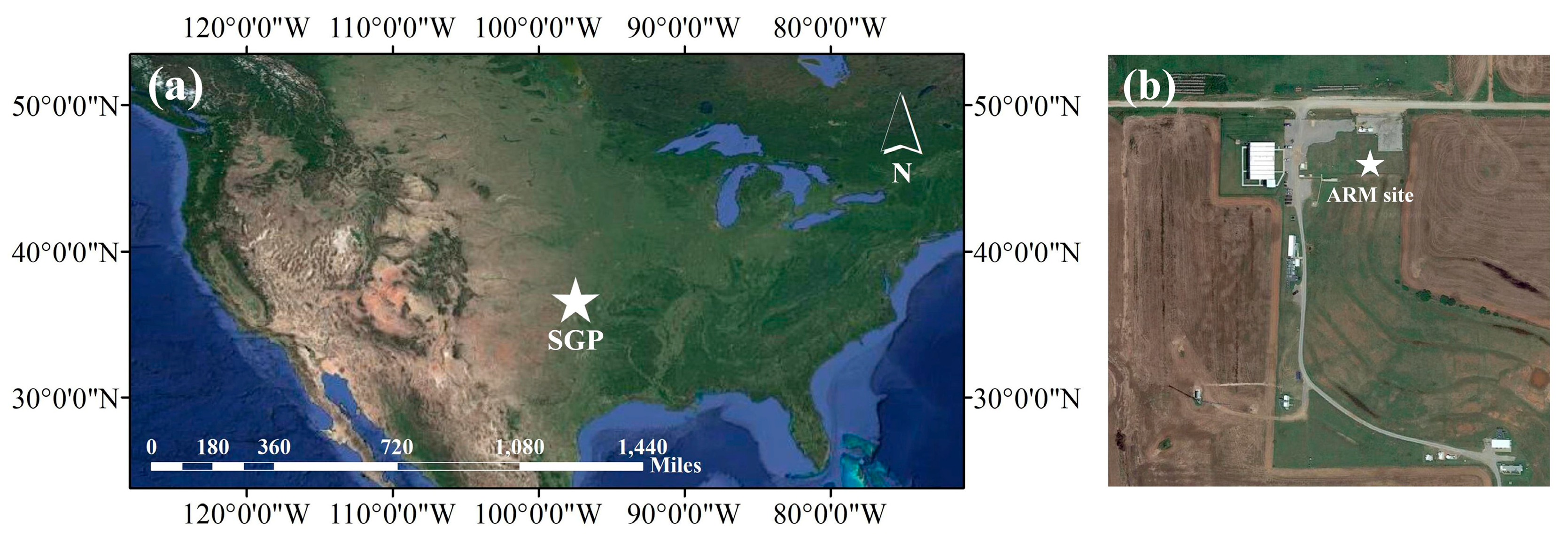

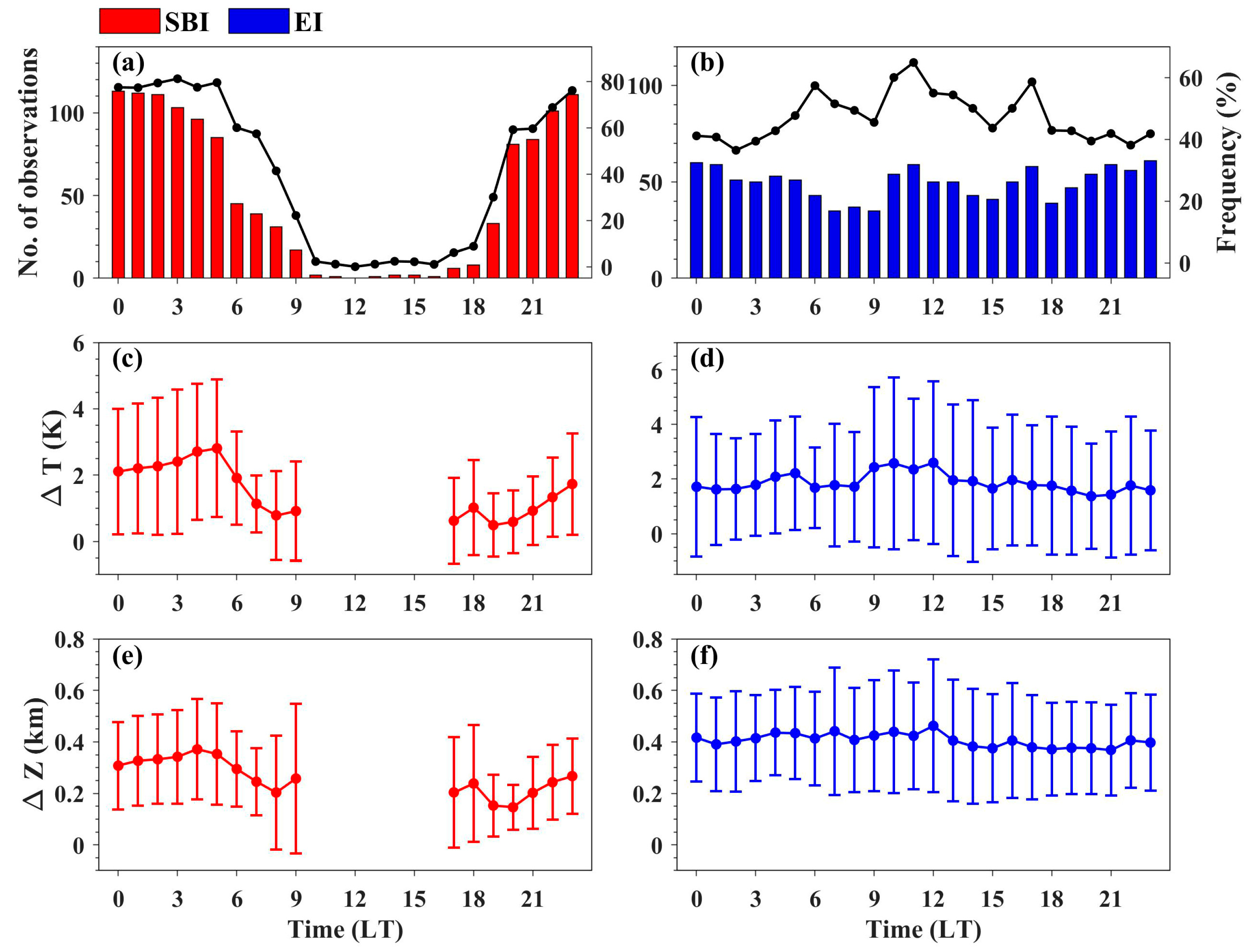
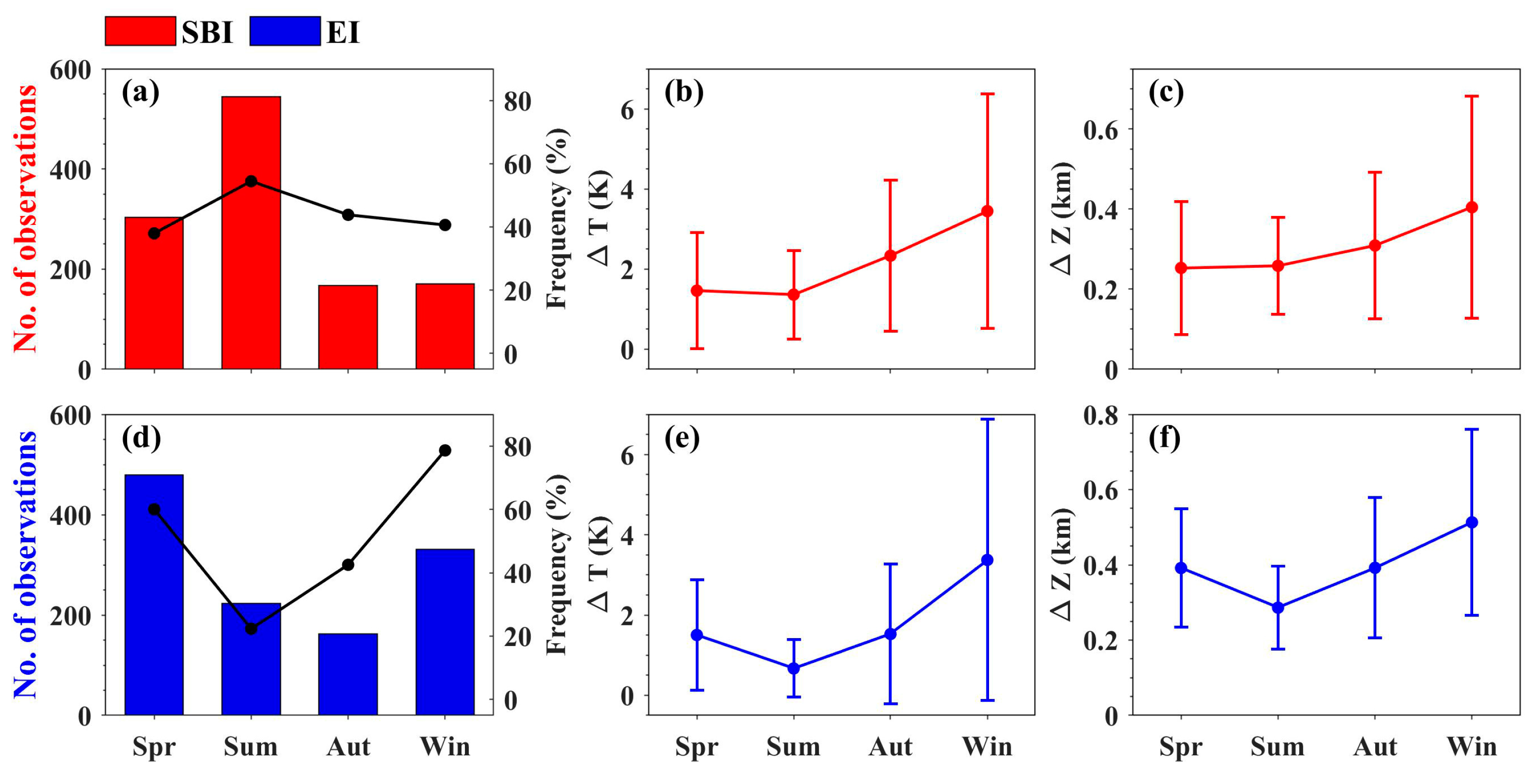
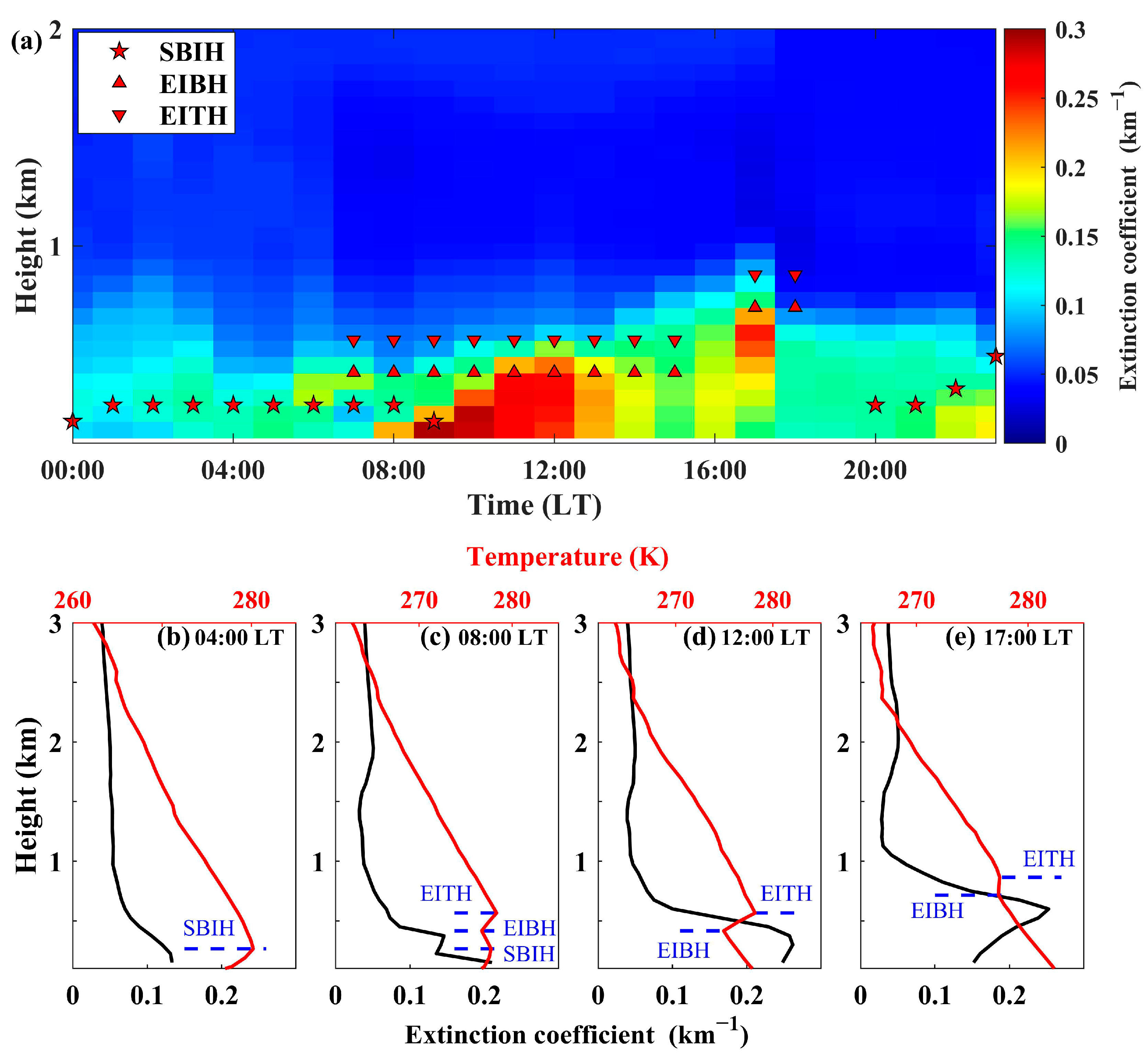

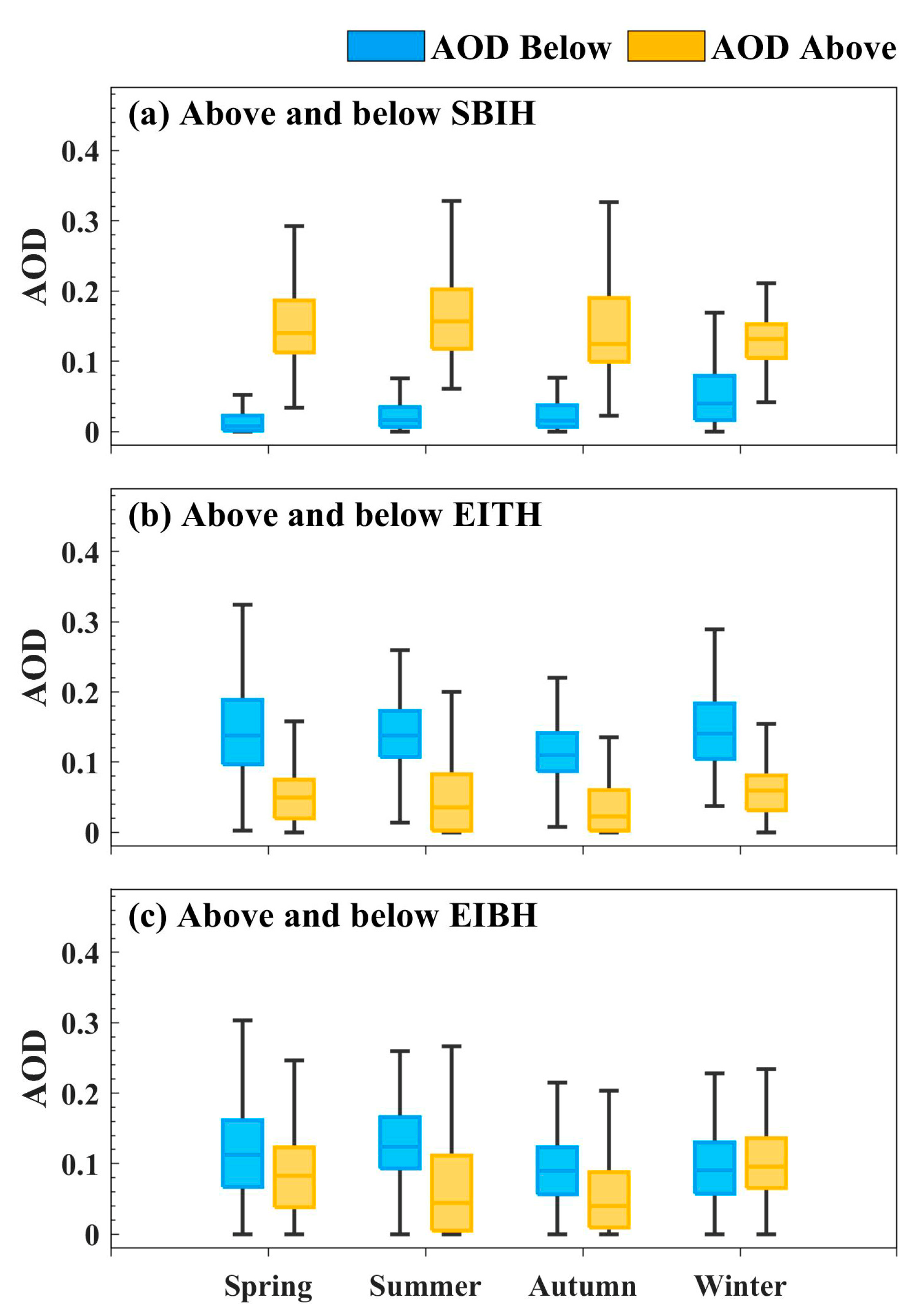
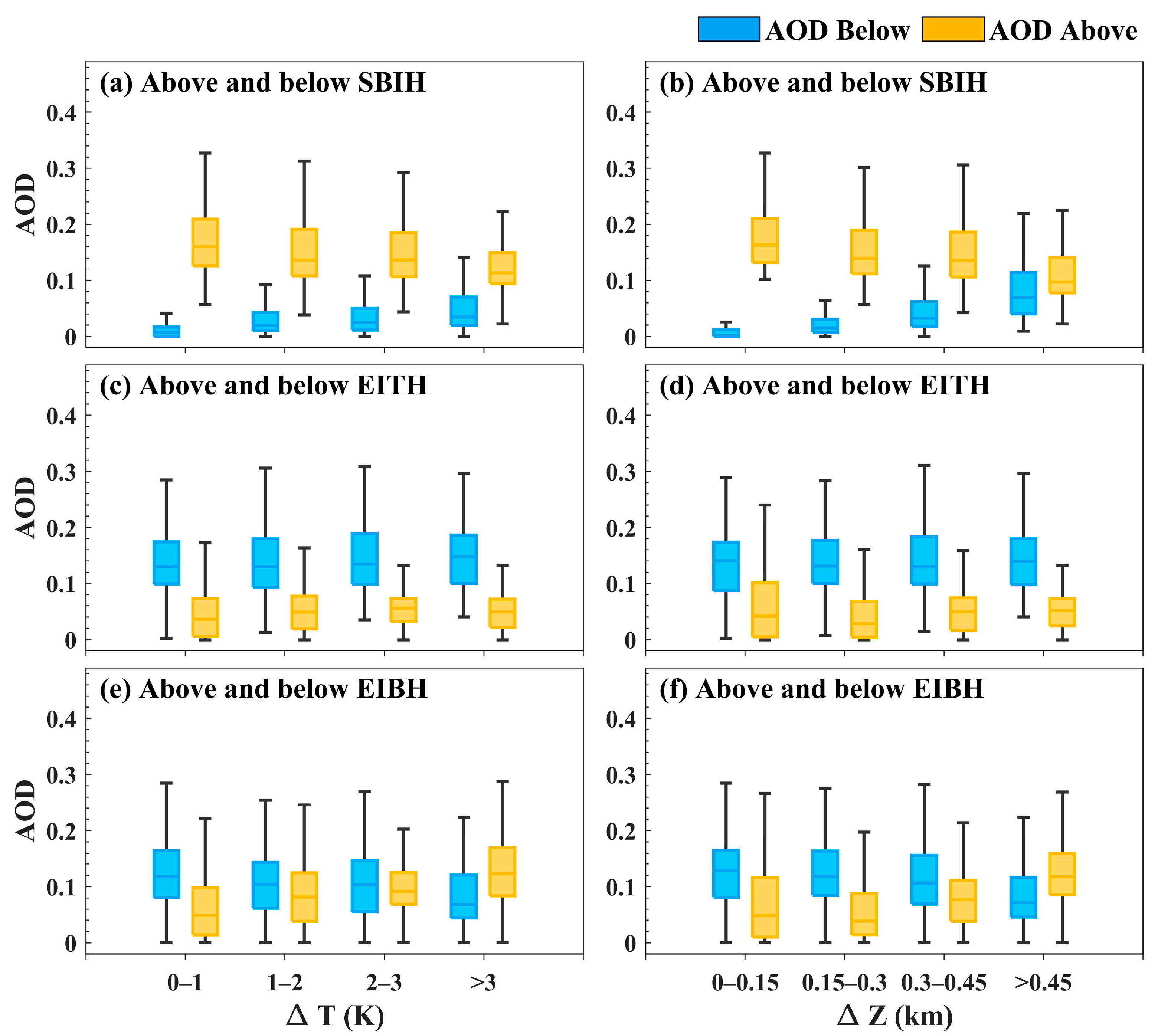
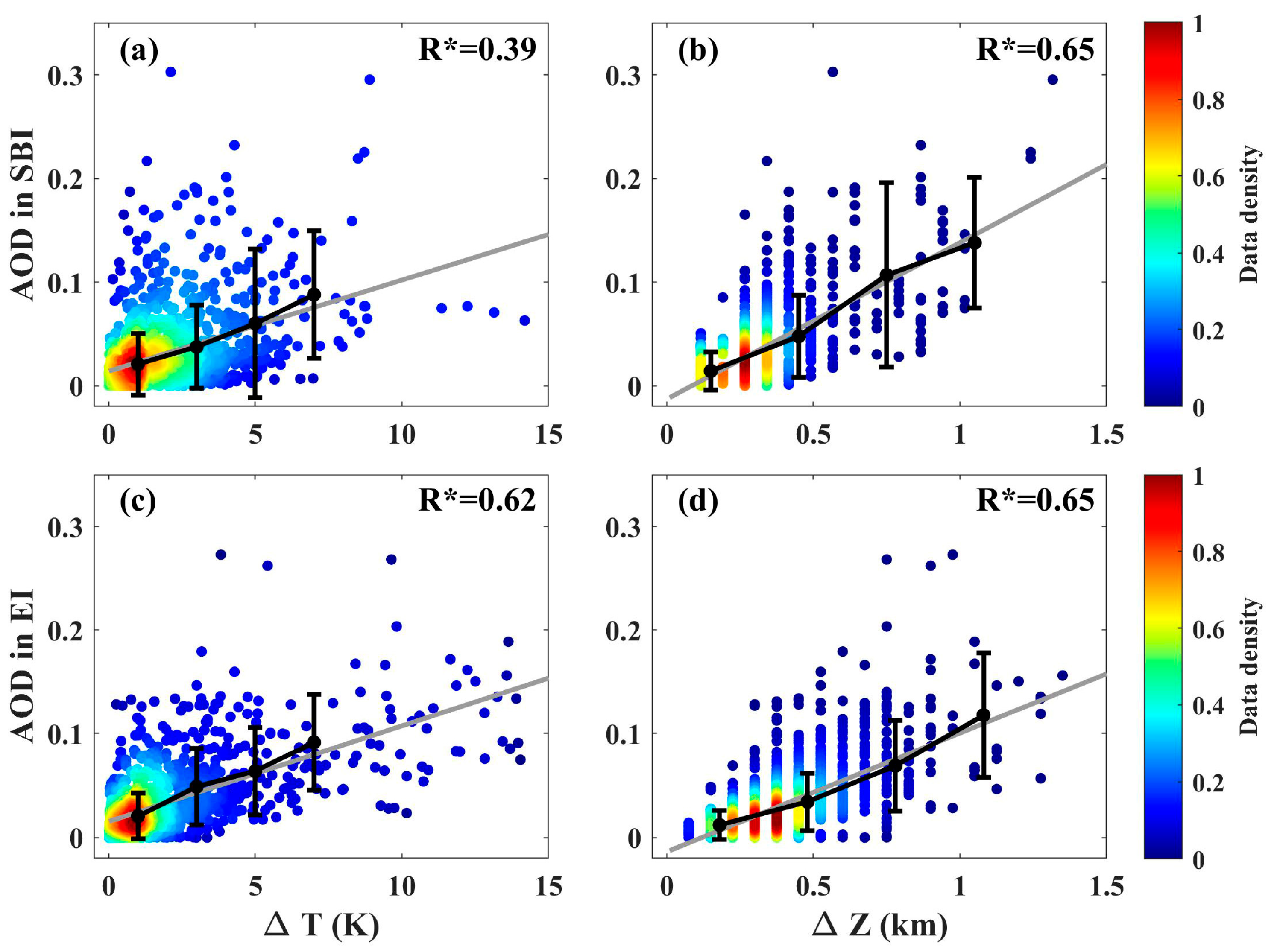
Publisher’s Note: MDPI stays neutral with regard to jurisdictional claims in published maps and institutional affiliations. |
© 2022 by the authors. Licensee MDPI, Basel, Switzerland. This article is an open access article distributed under the terms and conditions of the Creative Commons Attribution (CC BY) license (https://creativecommons.org/licenses/by/4.0/).
Share and Cite
Li, H.; Liu, B.; Ma, X.; Ma, Y.; Jin, S.; Fan, R.; Wang, W.; Fang, J.; Zhao, Y.; Gong, W. The Influence of Temperature Inversion on the Vertical Distribution of Aerosols. Remote Sens. 2022, 14, 4428. https://doi.org/10.3390/rs14184428
Li H, Liu B, Ma X, Ma Y, Jin S, Fan R, Wang W, Fang J, Zhao Y, Gong W. The Influence of Temperature Inversion on the Vertical Distribution of Aerosols. Remote Sensing. 2022; 14(18):4428. https://doi.org/10.3390/rs14184428
Chicago/Turabian StyleLi, Hui, Boming Liu, Xin Ma, Yingying Ma, Shikuan Jin, Ruonan Fan, Weiyan Wang, Jing Fang, Yuefeng Zhao, and Wei Gong. 2022. "The Influence of Temperature Inversion on the Vertical Distribution of Aerosols" Remote Sensing 14, no. 18: 4428. https://doi.org/10.3390/rs14184428
APA StyleLi, H., Liu, B., Ma, X., Ma, Y., Jin, S., Fan, R., Wang, W., Fang, J., Zhao, Y., & Gong, W. (2022). The Influence of Temperature Inversion on the Vertical Distribution of Aerosols. Remote Sensing, 14(18), 4428. https://doi.org/10.3390/rs14184428










